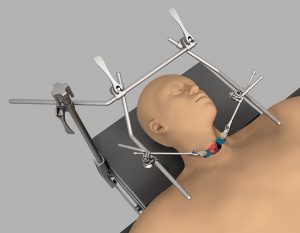In mild or early forms, medical treatments are instituted:
Pain medication (from simple analgesics to the prescription of morphine derivatives in very severe pain).
Anti-inflammatory drugs because the lesion is often accompanied by swelling and inflammation (anti-inflammatory drugs are prescribed if you tolerate them, gastric protective drugs are sometimes helpful). The most powerful anti-inflammatory drugs are corticosteroids.

- Medicines acting on muscle contracture, muscle relaxants.
- Immobilization of the neck with an orthopedic collar or neck brace is useful.
- Once the very painful period has passed, these medical treatments can be supplemented by rehabilitation sessions.
If the pain persists or worsens, infiltrations (injections of strong anti-inflammatory drugs) may be offered, often under the control of the scanner.
When to operate
The intervention is decided quickly and sometimes even urgently, if there is serious damage to the nerves, in particular paralysis. Often you will have to wait a few weeks of medical treatment before you are offered a surgical release procedure if it fails.
In agreement with your surgeon and according to the benefit-risk balance, you have been offered an anterior treatment for your cervical hernia. The surgeon has explained the other alternatives to you. It goes without saying that your surgeon may, if necessary depending on intraoperative findings or a difficulty encountered, proceed to another technique deemed by him to be more profitable for your specific case.
SURGICAL TREATMENT AND EXPECTED RESULTS
The principle of intervention
It consists in removing the herniated disc and thus releasing the compression of the nerve and / or the spinal cord with the help of cloward cervical retractor. The surgical procedure may not give a perfect result, especially if the nerve damage is very important (with deficient neurological disorders either sensory or motor), or if the compression was too long. The purpose of the intervention is to decompress the nervous structures by removing the herniated disc and possibly the sometimes associated bone structures built by osteoarthritis.
The approach from the front of the neck is currently chosen by the majority of surgeons, because it avoids mobilizing the spinal cord during the operation, which would be the case during an approach from the back (by the neck).
ANESTHESIA
General anesthesia is usually required for this procedure. A specific consultation with your anesthesiologist is currently essential and legally required to explain all the possible risks of anesthesia to you.
Some teams using minimally invasive techniques can perform this procedure under local anesthesia
THE CLASSIC INTERVENTION TAKES PLACE IN THE OPERATING BLOCK
The operation is usually done under general anesthesia. The right or left skin incision, horizontal or vertical, will be chosen by your surgeon and does not always correspond to the side of the pain. The operated patient is generally lying on his back in a semi-seated position, after having identified the level to be operated on by radiographic or fluoroscopic control.
It consists first of all in removing the diseased disc, then the herniation, and possibly the bone structures which participate in the compression.
The direct lesional approaches are made by an anterior approach, that is to say, the incision on your neck is made forward, slightly to the right or left side and the cervical spine is approached at the level of the middle part of the neck. ‘one or two discs. The surgeon passes between the muscles, blood vessels and nerves that run vertically along the spine and which are spread outward. The trachea and esophagus are spread apart towards the middle.
The diseased disc (s) are excised and a retractor is placed to restore the normal height of the space between two vertebral bodies (this space had greatly diminished due to the wear of the diseased disc). We can then create a hole in the ossification that sits behind the disc, either with a curette or with a small bur driven by compressed air. Through this hole, the surgeon then carefully inserts the thin end of a punch gouge and gradually eats away at the osteophyte. This surgical procedure is called cervical transdiscal osteophytectomy.
Sometimes, when the compression sits on two vertebral levels, the surgeon removes two adjacent discs as well as the vertebral body located between the two discs, this is called a cervical corporectomy.
Whether it is a transdiscal osteophytectomy or a corporectomy, once the cervical canal has been released, the spine must be re-stabilized and the curvature and height of the column segment operated on must be restored. The surgeon can use various techniques there: bone graft taken from your iliac crest (pelvic bone), procedure requiring an additional incision, bone substitute graft (there are several varieties), artificial cage placed between the vertebral bodies, very often a osteosynthesis is added by screwed metal plate or special clip. These metallic materials are nowadays most often made of titanium, a metal which does not disturb (unlike stainless steel) postoperative control by MRI or scanner.
Finally, some surgeons offer in some cases (when there is no osteoarthritis) a disc prosthesis, which is currently possible, but this technique is not supported by social security.
OTHER SURGICAL TECHNIQUES exist, depending on the experience of the surgeon and the indications. They aim to limit the surgical opening but have the same purpose as the classic intervention:
- Use of a microscope during the procedure.
- Percutaneous surgery with endoscopy.
DURATION OF THE INTERVENTION, including installation, varies according to the techniques used and the extent of the lesions. It is around an hour.
IS THERE A TRANSFUSION? Usually, transfusion is not necessary. Before closing the incision, a drainage system is put in place to prevent the appearance of a hematoma and to evacuate postoperative bleeding
For more details about surgical instruments, please visit: jimymedical.co.uk